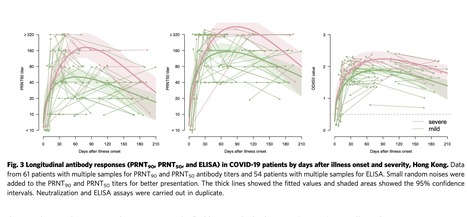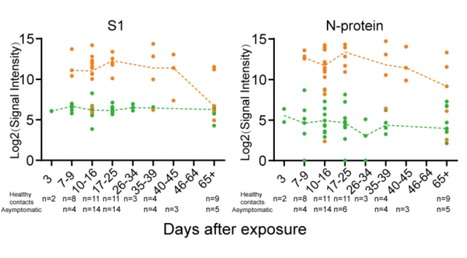 Your new post is loading...

|
Scooped by
Juan Lama
|
Predictive models of immune protection from COVID-19 are urgently needed to identify correlates of protection to assist in the future deployment of vaccines. To address this, we analyzed the relationship between in vitro neutralization levels and the observed protection from severe acute respiratory syndrome coronavirus 2 (SARS-CoV-2) infection using data from seven current vaccines and from convalescent cohorts. We estimated the neutralization level for 50% protection against detectable SARS-CoV-2 infection to be 20.2% of the mean convalescent level (95% confidence interval (CI) = 14.4–28.4%). The estimated neutralization level required for 50% protection from severe infection was significantly lower (3% of the mean convalescent level; 95% CI = 0.7–13%, P = 0.0004). Modeling of the decay of the neutralization titer over the first 250 d after immunization predicts that a significant loss in protection from SARS-CoV-2 infection will occur, although protection from severe disease should be largely retained. Neutralization titers against some SARS-CoV-2 variants of concern are reduced compared with the vaccine strain, and our model predicts the relationship between neutralization and efficacy against viral variants. Here, we show that neutralization level is highly predictive of immune protection, and provide an evidence-based model of SARS-CoV-2 immune protection that will assist in developing vaccine strategies to control the future trajectory of the pandemic. Estimates of the levels of neutralizing antibodies necessary for protection against symptomatic SARS-CoV-2 or severe COVID-19 are a fraction of the mean level in convalescent serum and will be useful in guiding vaccine rollouts. Published in Nature Medicine (May 17, 2021): https://www.nature.com/articles/s41591-021-01377-8

|
Scooped by
Juan Lama
|
The evolution of SARS-CoV-2 humoral response in infected individuals remains poorly characterized. Here, we performed a longitudinal study of sera from 308 RT-qPCR+ individuals with mild disease, collected at two time-points, up to 6 months post-onset of symptoms (POS). We performed two anti-S and one anti-N serology assays and quantified neutralizing antibodies (NAbs). At month 1 (M1), males, individuals > 50 years of age or with a body mass index (BMI) > 25 exhibited higher levels of antibodies. Antibody levels decreased over time. At M3-6, anti-S antibodies persisted in 99% of individuals while anti-N IgG were measurable in only 59% of individuals. The decline in anti-S and NAbs was faster in males than in females, independently of age and BMI. Our results show that some serology tests are less reliable overtime and suggest that the duration of protection after SARS-CoV-2 infection or vaccination will be different in women and men. Preprint available in medRxiv (Nov. 15, 2020): https://doi.org/10.1101/2020.11.12.20230466

|
Scooped by
Juan Lama
|
A study by U.S. researchers from Pennsylvania State University, Houston Methodist Hospital, Weill Cornell Medical College, and the CCDC Army Research laboratory in Austin, has investigated what’s the best time-window to collect plasma from COVID-19 convalescent patients. The researchers evaluated the changes with time in the levels of neutralizing antibodies (nAbs) against the virus in samples collected from 175 donors. The short answer: within the first 60 days after symptom onset. During this time, 80% of the individuals with any virus neutralization titer, display levels of neutralization above 160. This is the FDA-recommended value for use in COVID-19 convalescent plasma therapy. However, after this period, and during the next two months, the titers declined rapidly, and at some point only 20% of the individuals still maintain the recommended levels of neutralization. The researchers also confirmed that neutralization titers are greater if the patients have undergone severe COVID-19 disease, and when the individuals are older. Just the presence of dyspnea (shortness of breath) in the patients, increases the titer of nAbs. Similarly, plasma from individuals in the age interval 20-30, as compared to older than 60-year old patients, are significantly less likely to have the recommended levels of neutralization after 60 days from symptoms start. The study also confirmed the use of a simple ELISA assay to determine the levels of total antibodies against the receptor binding domain (RBD) of the viral spike protein, as an easy surrogate method to select plasma samples that will neutralize the virus. Virus neutralization assays are more time consuming, require several days, and need laboratory access to biosafety level 3 facilities. The study is available as preprint in bioRxiv (August 21, 2020): https://doi.org/10.1101/2020.08.21.261909
|

|
Scooped by
Juan Lama
|
The SARS-CoV-2 pandemic poses the greatest global public health challenge in a century. Neutralizing antibody is a correlate of protection and data on kinetics of virus neutralizing antibody responses are needed. We tested 293 sera from an observational cohort of 195 reverse transcription polymerase chain reaction (RT-PCR) confirmed SARS-CoV-2 infections collected from 0 to 209 days after onset of symptoms. Of 115 sera collected ≥61 days after onset of illness tested using plaque reduction neutralization (PRNT) assays, 99.1% remained seropositive for both 90% (PRNT90) and 50% (PRNT50) neutralization endpoints. We estimate that it takes at least 372, 416 and 133 days for PRNT50 titres to drop to the detection limit of a titre of 1:10 for severe, mild and asymptomatic patients, respectively. At day 90 after onset of symptoms (or initial RT-PCR detection in asymptomatic infections), it took 69, 87 and 31 days for PRNT50 antibody titres to decrease by half (T1/2) in severe, mild and asymptomatic infections, respectively. Patients with severe disease had higher peak PRNT90 and PRNT50 antibody titres than patients with mild or asymptomatic infections. Age did not appear to compromise antibody responses, even after accounting for severity. We conclude that SARS-CoV-2 infection elicits robust neutralizing antibody titres in most individuals. Published in Nature (Jan. 4, 2021): https://doi.org/10.1038/s41467-020-20247-4

|
Scooped by
Juan Lama
|
A provocative study suggests that certain colds may leave antibodies against the new coronavirus, perhaps explaining why children are more protected than adults. It’s been a big puzzle of the pandemic: Why are children so much less likely than adults to become infected with the new coronavirus and, if infected, less likely to become ill? A possible reason may be that many children already have antibodies to other coronaviruses, according to researchers at the Francis Crick Institute in London. About one in five of the colds that plague children are caused by viruses in this family. Antibodies to those viruses may also block SARS-CoV-2, the new coronavirus causing the pandemic. In a study published Friday in Science, the group, led by George Kassiotis, who heads the Retroviral Immunology Laboratory at the institute, reports that on average only 5 percent of adults had these antibodies, but 43 percent of children did. Researchers who did not participate in the study were intrigued by the finding. H. Benjamin Larman, an immunologist at Johns Hopkins School of Medicine, called it a “well-done study that puts forward a compelling theory which is supported by their data.” Stephen J. Elledge, a genetics professor at Harvard Medical School and Brigham and Women’s Hospital, had a similar response. He and others have found many people have antibodies to common colds caused by other coronaviruses; in laboratory studies, these antibodies also block the new coronavirus. In March, as the pandemic was just beginning, Dr. Kassiotis and his colleagues decided to develop a highly sensitive antibody test. To assess it, they examined blood samples taken before the pandemic from over 300 adults and 48 children and adolescents, comparing them with samples from more than 170 people who had been infected with the new coronavirus. The scientists expected samples taken before the pandemic to have no antibodies that attacked the new coronavirus. Those were to be the controls for the test the scientists were developing. Instead, they found that many children, and some adults, carried one antibody in particular that can prevent coronaviruses, including the new one, from entering cells. This antibody attaches itself to a spike that pokes out of coronaviruses. While the tip of the spike is unique to the new coronavirus, the base is found in all coronaviruses, Dr. Kassiotis said. In lab tests, antibodies to the base of the spike prevented the new coronavirus from entering cells in order to reproduce. Now the researchers are planning to expand their study to monitor thousands of children and adults. Some have antibodies that can block the new coronavirus in lab tests. Others do not. “If they have the pandemic strain, are they protected?” Dr. Kassiotis asked. Will they get sick, he wondered, or will the infection be all but undetectable? Dr. Elledge and his colleagues at Harvard developed their own highly specific, sensitive and exhaustive antibody test, VirScan. It is able to detect a diverse collection of antibodies with that are directed at any of more than 800 places on the new coronavirus, including the antibody that Dr. Kassiotis and his colleagues studied. After examining blood taken from 190 people before the pandemic emerged, Dr. Elledge and his colleagues concluded that many already had antibodies, including the one targeting the base of the spike — presumably from infections with related coronaviruses that cause colds... Cited study published in Science (Nov. 6, 2020): https://doi.org/10.1126/science.abe1107

|
Scooped by
Juan Lama
|
Humoral immunity in asymptomatic infections with SARS-CoV-2 has not been well established. 63 healthy contacts, 63 asymptomatic individuals, and 51 mild patients were enrolled in this study and screened using nucleic acid testing (NAT) and commercial kits of serum IgM and IgG antibodies against recombinant nucleoprotein (N) and spike (S) proteins of SARS-CoV-2. Asymptomatic and mild patients were classified into at least four types based on NAT and serological tests, especially 81% and 25.4% negative NAT but positive IgM/IgG responses, respectively. Antibody dynamics were further demonstrated by IgM and IgG profile responses to SARS-CoV-2 proteome. IgM antibody responses against S1 were elicited in asymptomatic individuals as early to the seventh day after exposure and peaked on days from 17d to 25d, which might be used as early diagnostic biomarkers. Moreover, asymptomatic individuals evoked weaker S1 specific IgM and neutralizing antibody responses than mild patients. Most importantly, S1 specific IgM/IgG responses and the titers of neutralizing antibody in asymptomatic individuals gradually vanished in two months. Our findings might have important implications for serological survey, public health and immunization strategy. Preprint available at medRxiv (July 11, 2020): https://doi.org/10.1101/2020.07.09.20149633
|



 Your new post is loading...
Your new post is loading...












